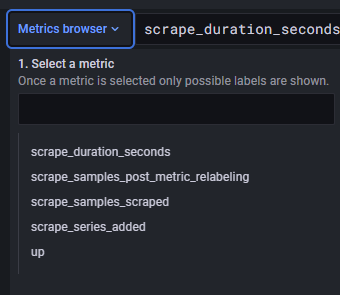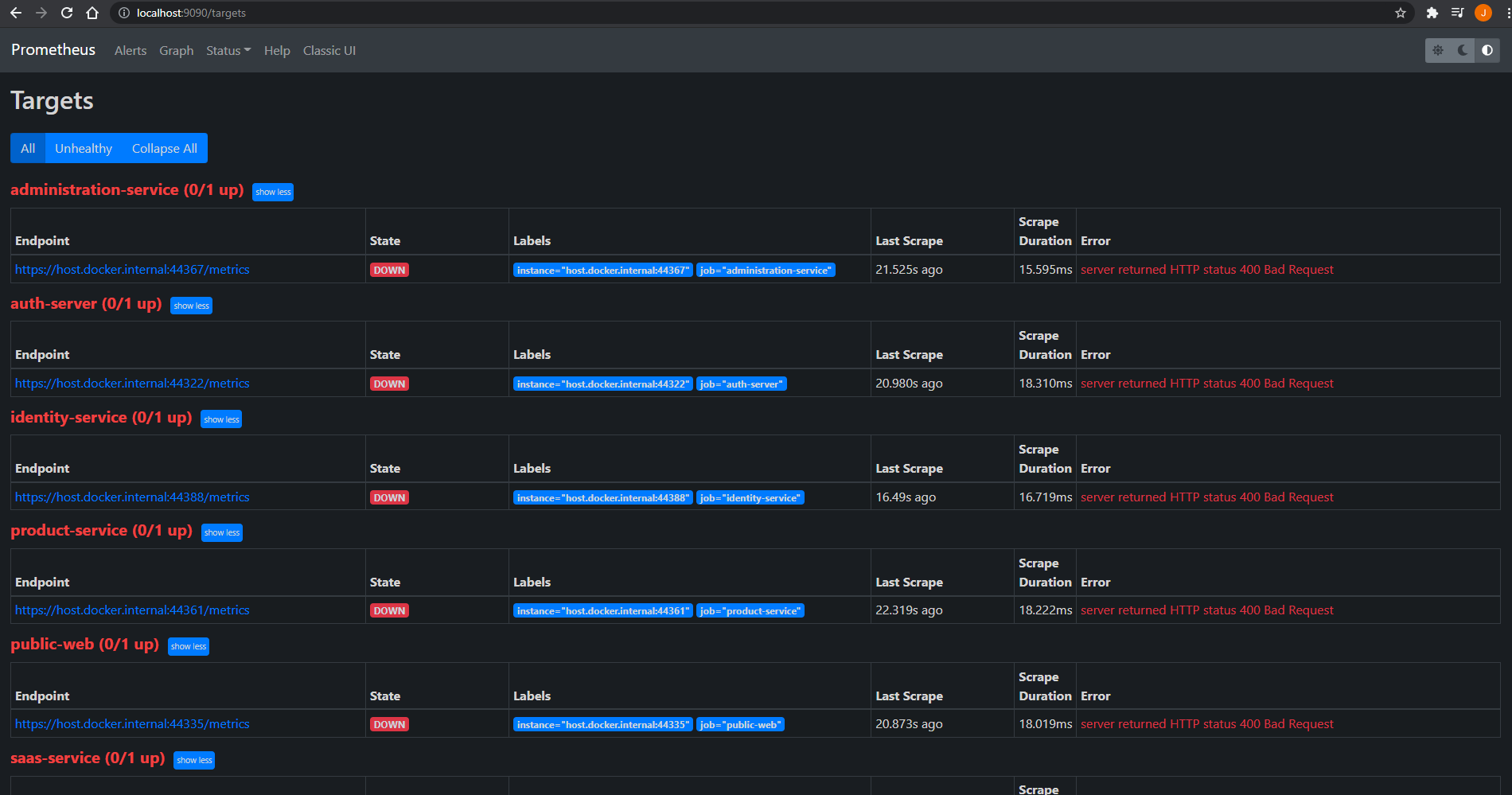Hi there,
I have a Razor form that is creating a new entry in the database with a Name field that must be unique. I am performing server-side validation in the OnPostAsync method and if the submitted Name entry already exists in the database, the method returns an error. The returned error object is a Microsoft.AspNetCore.Mvc.ContentResult with the StatusCode set to 400 and the Content set to an error message stating the submitted name already exists, this causes the ABP "An error has occurred!" modal to pop up but the message is not displayed, and instead the modal just says "Error detail not sent by server.". How do I properly return an error from the server side so that my custom error message can be displayed?
Thank you!
Hi, thank you for the clarification, however after resolving the errors and getting all the applications running we are still running into the Prometheus error as shown above. All the other infrastructure services are working except for Prometheus. Any solution you could provide would be much appreciated. Thanks
You need to add prometheus data in Grafana UI as far as I remember. Sorry, I don't have much knowledge about Grafana and Prometheus.
You can also remove them from your
docker-compose.infrastructure.yml(also from .override) file if you are not using.
Hi there, we want to use Prometheus and Grafana in our project. I've added Prometheus as a datasource in Grafana, and when I create a dashboard using Prometheus as a datasource I can see metrics I can add to the dashboard:  However there really isn't any data to show as the Prometheus targets page still shows the same errors as above. Is there anything you can think of to resolve this, or would you recommend I contact Prometheus support?
Thanks
However there really isn't any data to show as the Prometheus targets page still shows the same errors as above. Is there anything you can think of to resolve this, or would you recommend I contact Prometheus support?
Thanks
Microservice template is more complex than monolith solutions because of the nature of microservice development itself. Main solution doesn't consist all the projects but just the runnable projects. So that you need to manually build all the referenced projects by yourself if you are not using tye.
AdministrationService.EntityFrameworkCoreversion mismatch is related with local nuget cache referance and we are investigating if there is a configuration error on our side or if there is a bug on Microsoft side.Currently, removing
PrivateAssetsandIncludeAssetsto set default in AdministrationService.EntityFrameworkCore.csproj file seems to fix the version mismatch as shown above.
Hi, thank you for the clarification, however after resolving the errors and getting all the applications running we are still running into the Prometheus error as shown above. All the other infrastructure services are working except for Prometheus. Any solution you could provide would be much appreciated. Thanks
hi
SqlException: Cannot open database "test_Administration" requested by the login. The login failed. Login failed for user 'sa'.
Please check the username and password of the database. Have you migrated the database?
Hi there, this worked, all applications and services are running succesfully as per the tutorial and we are able to run the Web and PublicWeb applications. The final issue we are running into though is with the infrastructure services, specifically Prometheus:

Is there any additional configuration in Docker/Prometheus/Solution we need to perform? Thanks
hi
Can you try to remove
IncludeAssetsandPrivateAssets?
Hi there, I'm working on the same project with NickCoatzee, this solution seems to have worked but we are now running into an error with the test_Administration database:
SqlException: Cannot open database "test_Administration" requested by the login. The login failed. Login failed for user 'sa'. Microsoft.Data.SqlClient.SqlInternalConnection.OnError(SqlException exception, bool breakConnection, Action<Action> wrapCloseInAction) Microsoft.Data.SqlClient.TdsParser.ThrowExceptionAndWarning(TdsParserStateObject stateObj, bool callerHasConnectionLock, bool asyncClose) Microsoft.Data.SqlClient.TdsParser.TryRun(RunBehavior runBehavior, SqlCommand cmdHandler, SqlDataReader dataStream, BulkCopySimpleResultSet bulkCopyHandler, TdsParserStateObject stateObj, out bool dataReady) Microsoft.Data.SqlClient.TdsParser.Run(RunBehavior runBehavior, SqlCommand cmdHandler, SqlDataReader dataStream, BulkCopySimpleResultSet bulkCopyHandler, TdsParserStateObject stateObj) Microsoft.Data.SqlClient.SqlInternalConnectionTds.CompleteLogin(bool enlistOK) Microsoft.Data.SqlClient.SqlInternalConnectionTds.AttemptOneLogin(ServerInfo serverInfo, string newPassword, SecureString newSecurePassword, bool ignoreSniOpenTimeout, TimeoutTimer timeout, bool withFailover) Microsoft.Data.SqlClient.SqlInternalConnectionTds.LoginNoFailover(ServerInfo serverInfo, string newPassword, SecureString newSecurePassword, bool redirectedUserInstance, SqlConnectionString connectionOptions, SqlCredential credential, TimeoutTimer timeout) Microsoft.Data.SqlClient.SqlInternalConnectionTds.OpenLoginEnlist(TimeoutTimer timeout, SqlConnectionString connectionOptions, SqlCredential credential, string newPassword, SecureString newSecurePassword, bool redirectedUserInstance) Microsoft.Data.SqlClient.SqlInternalConnectionTds..ctor(DbConnectionPoolIdentity identity, SqlConnectionString connectionOptions, SqlCredential credential, object providerInfo, string newPassword, SecureString newSecurePassword, bool redirectedUserInstance, SqlConnectionString userConnectionOptions, SessionData reconnectSessionData, bool applyTransientFaultHandling, string accessToken, DbConnectionPool pool) Microsoft.Data.SqlClient.SqlConnectionFactory.CreateConnection(DbConnectionOptions options, DbConnectionPoolKey poolKey, object poolGroupProviderInfo, DbConnectionPool pool, DbConnection owningConnection, DbConnectionOptions userOptions) Microsoft.Data.ProviderBase.DbConnectionFactory.CreatePooledConnection(DbConnectionPool pool, DbConnection owningObject, DbConnectionOptions options, DbConnectionPoolKey poolKey, DbConnectionOptions userOptions) Microsoft.Data.ProviderBase.DbConnectionPool.CreateObject(DbConnection owningObject, DbConnectionOptions userOptions, DbConnectionInternal oldConnection) Microsoft.Data.ProviderBase.DbConnectionPool.UserCreateRequest(DbConnection owningObject, DbConnectionOptions userOptions, DbConnectionInternal oldConnection) Microsoft.Data.ProviderBase.DbConnectionPool.TryGetConnection(DbConnection owningObject, uint waitForMultipleObjectsTimeout, bool allowCreate, bool onlyOneCheckConnection, DbConnectionOptions userOptions, out DbConnectionInternal connection) Microsoft.Data.ProviderBase.DbConnectionPool.WaitForPendingOpen() Microsoft.EntityFrameworkCore.Storage.RelationalConnection.OpenInternalAsync(bool errorsExpected, CancellationToken cancellationToken) Microsoft.EntityFrameworkCore.Storage.RelationalConnection.OpenInternalAsync(bool errorsExpected, CancellationToken cancellationToken) Microsoft.EntityFrameworkCore.Storage.RelationalConnection.OpenAsync(CancellationToken cancellationToken, bool errorsExpected) Microsoft.EntityFrameworkCore.Storage.RelationalCommand.ExecuteReaderAsync(RelationalCommandParameterObject parameterObject, CancellationToken cancellationToken) Microsoft.EntityFrameworkCore.Query.Internal.SplitQueryingEnumerable<T>+AsyncEnumerator.InitializeReaderAsync(DbContext _, bool result, CancellationToken cancellationToken) Microsoft.EntityFrameworkCore.SqlServer.Storage.Internal.SqlServerExecutionStrategy.ExecuteAsync<TState, TResult>(TState state, Func<DbContext, TState, CancellationToken, Task<TResult>> operation, Func<DbContext, TState, CancellationToken, Task<ExecutionResult<TResult>>> verifySucceeded, CancellationToken cancellationToken) Microsoft.EntityFrameworkCore.Query.Internal.SplitQueryingEnumerable<T>+AsyncEnumerator.MoveNextAsync() Microsoft.EntityFrameworkCore.EntityFrameworkQueryableExtensions.ToListAsync<TSource>(IQueryable<TSource> source, CancellationToken cancellationToken) Microsoft.EntityFrameworkCore.EntityFrameworkQueryableExtensions.ToListAsync<TSource>(IQueryable<TSource> source, CancellationToken cancellationToken) Volo.Abp.LanguageManagement.EntityFrameworkCore.EfCoreLanguageRepository.GetListByIsEnabledAsync(bool isEnabled, CancellationToken cancellationToken) Castle.DynamicProxy.AsyncInterceptorBase.ProceedAsynchronous<TResult>(IInvocation invocation, IInvocationProceedInfo proceedInfo) Volo.Abp.Castle.DynamicProxy.CastleAbpMethodInvocationAdapterWithReturnValue<TResult>.ProceedAsync() Volo.Abp.Uow.UnitOfWorkInterceptor.InterceptAsync(IAbpMethodInvocation invocation) Volo.Abp.Castle.DynamicProxy.CastleAsyncAbpInterceptorAdapter<TInterceptor>.InterceptAsync<TResult>(IInvocation invocation, IInvocationProceedInfo proceedInfo, Func<IInvocation, IInvocationProceedInfo, Task<TResult>> proceed) Volo.Abp.LanguageManagement.DatabaseLanguageProvider.KkJsFLNKt() Volo.Abp.Caching.DistributedCache<TCacheItem, TCacheKey>.GetOrAddAsync(TCacheKey key, Func<Task<TCacheItem>> factory, Func<DistributedCacheEntryOptions> optionsFactory, Nullable<bool> hideErrors, bool considerUow, CancellationToken token) Volo.Abp.LanguageManagement.DatabaseLanguageProvider.GetLanguagesAsync() Microsoft.AspNetCore.RequestLocalization.DefaultAbpRequestLocalizationOptionsProvider.GetLocalizationOptionsAsync() Microsoft.AspNetCore.RequestLocalization.AbpRequestLocalizationMiddleware.InvokeAsync(HttpContext context, RequestDelegate next) Microsoft.AspNetCore.Builder.UseMiddlewareExtensions+<>c__DisplayClass6_1+<<UseMiddlewareInterface>b__1>d.MoveNext() Microsoft.AspNetCore.Diagnostics.DeveloperExceptionPageMiddleware.Invoke(HttpContext context)
Thanks

